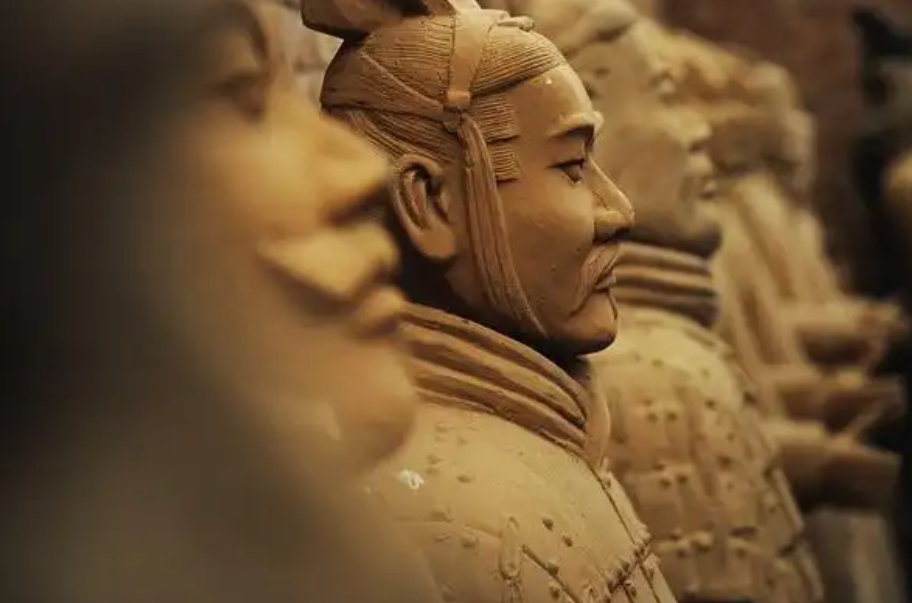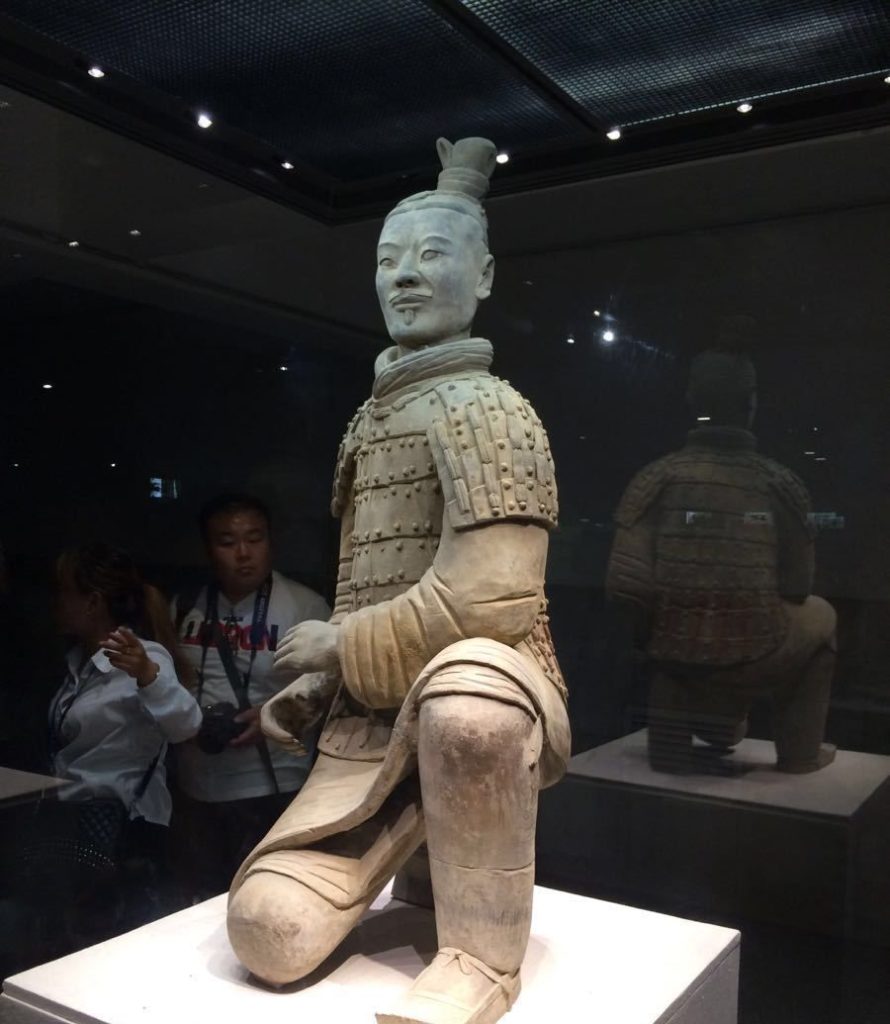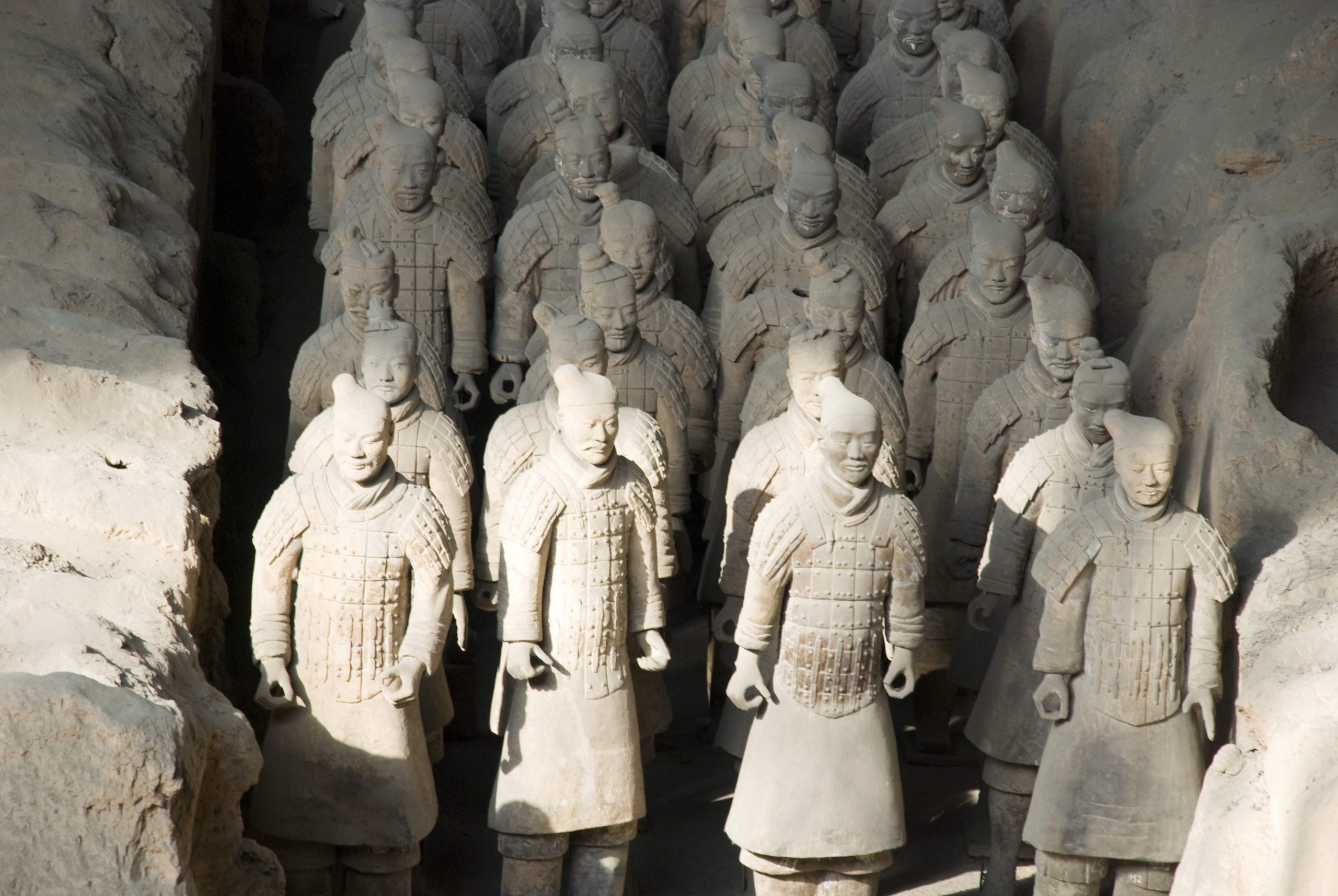Made of terracotta, the warriors were 🎎 Just the name makes one picture thousands of life-sized clay soldiers in silent formation guarding the tomb of Qin Shi Huang, the first Emperor of China. Still enthralls the entire globe🌎 this amazing archeological find, which was unearthed in 1974 close to Xi’an China. It offers a first-rate look at the military might and artistic achievements of the Qin Dynasty, which spanned 221–206 BC. These fighters, with their own unique facial traits, haircuts, and weapons, are more than just relics from a bygone age; rather, they are a window through which one might see a momentous historical event and show the inventiveness of people.
The discovery has absolutely massive scope. Excavation of several sizable pits has revealed not only soldiers but also horses🐎, chariots, and a great variety of weapons🗡️. Declared as a UNESCO World Heritage Site, the site honors its great historical and cultural relevance. The continuous excavations and studies that reveal fresh secrets are driving the passion people all around have with this ancient wonder.
Beyond just seeing the Terracotta Army, more and more people—including history buffs, archaeologists, and even casual visitors—are intrigued in exploring. This is so due to the amazing relevance of the Terracotta Army. Many people aspire to be more involved, where they can help to support continuous research and preservation of this amazing site. The question that has to be addressed is: Is it feasible for an ordinary person to participate in Terracotta Warrior related archeological digs? Though it is complex, the response is definitely a resounding “yes,” and depending on your background, aptitudes, and degree of dedication, you have several different paths forward.
Volunteering: The Roles That Fit

Visiting the vast complex built around the excavation pits, the Museum of the Terracotta Army helps one to better appreciate the warriors. It is also a possible point of access for those who would want to participate in the practical work. There are chances for volunteers to help the museum run even though only qualified experts are allowed direct touch with the artifacts. These chances mostly aim to improve the experience of museum visitors.
Consider roles including helping with visitor services. This could call for guiding tour groups, offering information, helping with crowd control, or making sure guests flow naturally across the displays. Making sure the grounds of the museum and the surrounding areas remain as immaculate as they should also be a great responsibility. Volunteers can help with general maintenance, landscaping, and ensuring the site is kept in perfect shape for the hundreds of daily visitors.
Managing expectations is absolutely vital. Usually, there is no direct interaction with the Terracotta Warriors themselves involved in these volunteer roles. The main goal is to support the general mission of the museum—preserving and enlightening the public. Having said that, the very fulfilling achievement of being totally submerged in this environment surrounded by the history and energy of the site is in and of itself. Here is the chance to, if indirectly, help to preserve the legacy of the Terracotta Army.
Furthermore noteworthy is the fact that volunteering can be a useful stepping stone. This shows your dedication to the site, allows you to network with employees, and exposes you to the running activities of the museum. If you are seeking more specialized involvement opportunities, all of these things could prove useful down road.
Projects involving excavation: peering further into the past
Not even close to completion in terms of Terracotta Army site excavation. This is an enormous project carried on constantly, and regular new discoveries are made. As so, one questions their direct capacity to participate in an excavation. Still, it is quite crucial to understand that these are highly specialized and professional projects.
Participating in a real excavation at the Terracotta Army site is quite challenging, and usually only qualified archaeologists with academic credentials and a great degree of experience are involved. Most of the time, this requires having a Master’s degree or occasionally even a Ph.D., in archaeology or another closely related field. Crucially also is a proven background in excavation techniques, artifact handling, and archaeological recording approaches.
Furthermore, these initiatives are regularly carried out under the direction of Chinese universities and research institutes, under strict rules and procedures. Foreign archaeologists can engage in cooperative projects, but usually these are quite competitive and depend on established ties between different institutions.
The work is meticulous, thus accuracy and experience are needed criteria. Every single shard of pottery and fragment of bronze undergo extensive documentation and inspection. The process is labor-intensive, slow, and calls for a lot of patience; hence, one must have a strong awareness of archaeological ideas and conservation methods.
The secret of knowledge is academic world research
Although direct excavation may be out of reach for most people, contributing to the great body of knowledge about the Terracotta Warriors by academic research is a realistic and quite valuable route. One can achieve this in several ways, including collaborating with already-existing research teams or running individual projects.
Research initiatives linked to the Terracotta Army are now under way at many universities, both inside China and abroad. From the study of the social and political environment of the Qin Dynasty to the analysis of the tools and materials used in the formation of the warriors, these projects cover a broad spectrum of disciplines. Working with these organizations could present chances to engage in fieldwork, literature reviews, or even data analysis—albeit, once more, direct excavation is quite unlikely.
Independent research is another possibility, which one could pursue either for a master’s thesis or a doctorate dissertation. To achieve this, one must develop a strong research proposal, get the required licenses and ethical approvals, and maybe cooperate with Chinese academics and institutions. The study itself could cover more general issues connected with the Qin Dynasty or it could involve the investigation of specific features of the warriors, such their weaponry, armor, or facial traits.
Although permission for specific research projects is obtainable, access to the site and artifacts for the aims of study is tightly under control. Usually, this means proving the intellectual value of the research, showing the relevant authorities a thorough proposal, and following strict procedures for the handling and recording of any objects under examination.
Engaging in training programs and internships helps one to get experience
For those who want to acquire useful skills and knowledge about archaeology and conservation, internships and training courses present great possibilities. Those looking for a more regimented educational experience have these chances. Although there might be a small number of internships directly involving the Terracotta Warriors, museums and archeological organizations all around the world provide a great range of programs focused on related subjects.
These internships could call for working in conservation labs, learning about methods for artifact preservation, helping with archaeological cataloging and documentation, or learning design and curation of museum exhibits. The acquired skills and knowledge are quite flexible and provide a strong basis for next participation in archaeological digs. This is true even if the Terracotta Army’s particular importance is not especially highlighted.
Usually run by colleges or other specialized institutions, training courses give more in-depth knowledge in archaeological methods, conservation techniques, and cultural heritage management. These courses might run a few days to many months, and they can even include diploma or certificate programs. Often included in these programs are classroom instruction and practical experience gained by hands-on work.
Through internships and training courses, you can greatly raise your chances of future participation in Terracotta Army related projects. This is so because it shows a great dedication to the field and will greatly increase your possibilities of future participation.

Public involvement and workshops allow one to share the wonder about
Though you have no official training in archaeology, you can still be very important in spreading the story of the Terracotta Warriors and encouraging public awareness of the relevance of their existence. Participating in public engagement events and seminars will help one to establish a link with this interesting past and inspire others.
Many different cultural organizations and museums present public lectures and workshops covering the Terracotta Warriors. Participants in the course of these activities will have the opportunity to ask questions, learn from experts, and explore the history and archaeology of the area more closely. Engaging in these activities is a great approach to increase your knowledge and establish relationships with other people driven by your enthusiasm.
Many seminars even give attendees the chance to engage in practical activities including demonstrations of pottery-making, so allowing them to experience the workmanship required in the production of like objects. Other events could center on methods of artifact restoration, so providing a window into the laborious effort required in safeguarding these priceless relics.
Your active participation in these public engagement events will help you to join a community dedicated to sharing the wonder that the Terracotta Warriors reflect and to preserve their legacy for next generations.
Engaging in Citizen Science: Compiling Data
The spread of citizen science has made it feasible for people without specialized knowledge in a given field to engage in fascinating new scientific activities including in the field of archaeology. Citizen science initiatives leverage crowdsourcing to address big projects that would be unmanageable for individual researchers to handle on their own.
Although there might be few citizen science projects especially targeted on the Terracotta Warriors, there are more general archeological projects that would profit from public participation. Tasks falling under this category could include cataloguing objects from other archeological sites, transcribing ancient texts, or using aerial photography to spot possible archeological features.
The availability of online platforms and databases helps volunteers to contribute their time and knowledge from anywhere in the globe, so simplifying these initiatives. Because they help to process enormous volumes of data and identify trends or anomalies that might otherwise be missed, contributions made by citizen scientists can be quite valuable to researchers.
Participating in citizen science research projects will help you significantly advance the field of archaeology even if the Terracotta Warriors have no direct bearing on the studies under way. The acquired knowledge and experience can also be valuable for next involvement in initiatives needing more degree of specialization.
Including immersive learning, educational field schools and tours
To have a more immersive and hands-on learning experience, you might want to think about joining an educational tour or field school centred on the Terracotta Warriors. Participating in these events offers a unique chance to visit Xi’an, learn straight from experts in the field, and travel to another country.

Usually, educational tours feature the Museum of the Terracotta Army and other important historical sites in the vicinity. Usually, these tours also feature guided museum visits. Their goal is to give a complete background and insights on the Terracotta Warriors and the relevance of their existence, thus they regularly include presentations and talks headed by archaeologists and historians.
Conversely, field schools offer a more all-encompassing and useful experiential learning possibility. Participating in excavations at other nearby sites, learning about excavation methods, artifact analysis, and site preservation—field schools can expose students to While direct Terracotta Warrior excavation is improbable, field schools could entail involvement in excavations at other nearby sites. Many times, working with seasoned archaeologists, participants in these programs have the chance to acquire useful field skills.
Apart from offering priceless learning chances, field schools and educational tours give the chance to interact with the Terracotta Warrior history in a way that is both very important and meaningful.
Globally cooperative efforts inside international institutions
To study and protect the Terracotta Warriors, Chinese institutions and companies spread all around the globe are working together on a worldwide project. When international institutions engaged in this activity create alliances with one another, it creates chances for involvement in cooperative projects and initiatives advancing cultural interchange.
Many museums, colleges, and research facilities all around the world have partnered with their Chinese counterparts to help with research, conservation, and displays pertaining to the Terracotta Warriors, numerous other sites. Common elements of these kinds of partnerships are the sharing of knowledge, the researcher exchange, and the execution of cooperative projects.
Engaging in these international projects offers unique chances to work with top experts from many cultural backgrounds and contribute to the general worldwide knowledge of the Terracotta Warriors. Activities that might fit under this category include attending seminars or conferences, doing research, or helping to create exhibits and instructional programs.
By means of cultural exchange initiatives, students, scholars, and professionals have the chance to visit China and interact with Chinese culture and legacy. Usually, government agencies or national cultural organizations help to organize these events. Participating in these events could be a helpful approach to learn about the Terracotta Warriors, build relationships with Chinese colleagues, and develop a more deep awareness of the conditions under which these historic treasures were created.
Starting Your Trip: Starting Your Path

Should you be driven to engage in Terracotta Warrior-related archeological activities, there are several actions you can take to get yourself ready and raise your chances of success.
First, build a skill set relevant for the circumstances. One could start in this direction with the completion of courses in archaeology, history, art history, or conservation. Crucially important also is the development of strong research skills including critical thinking and data analysis capability. Learning Mandarin Chinese🇨🇳 can be quite beneficial since it will allow one access to more resources and possibilities.
The next action is searching for chances to obtain experience. Valuable ways to pass your time are by going to seminars and lectures, helping museums or archeological societies, or working on citizen science projects. Though these events have nothing to do with the Terracotta Warriors, they will still help you grow in useful skills and widen your network.
At last, make it a point to aggressively look for chances for involvement. One should monitor the websites of pertinent companies, including professional archaeologists, universities with archaeology courses, and the Museum of the Terracotta Army. Make contacts with archaeologists and researchers, attend conferences, and let others know you would be interested in helping out on initiatives.
Essential are relentless commitment and hard labor. Though there might be few chances for direct participation with the Terracotta Warriors, there are many ways one might help to understand and preserve this amazing site. By aggressively searching for possibilities, compiling experience, and honing your abilities, you increase your chances of realizing your dream of participating in the continuing narrative of the Terracotta Army. This will help you raise your possibility of realizing your dream.

The Legacy To Last Always
Displayed in their present site, the Terracotta Warriors are silently monuments to a strong empire and a great artistic accomplishment. The chances to directly participate in their excavation could be few and reserved for professionals with great degree of competence. On the other hand, there are shockingly different ways one might honor their legacy. People with a range of backgrounds and skill sets can engage in a range of events including volunteering at the museum, helping with academic research, taking part in citizen science projects, and accompanying instructional tours.


